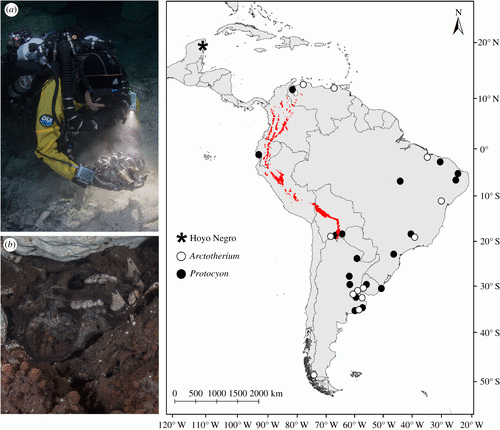Fossils Of Giant Ice Age Bear and Ancient Humans Discovered in Underwater Cave

Ice Age fossils of humans and animals were recently discovered in an underwater cave in Mexico. Researchers found an ancient graveyard that contained the remains of ancient humans as well as long-extinct species of animals.
The remains belong to ancient creatures such as giant bears, wolf-like dogs, saber-toothed cats, sloths, cougars, elephant-like gomphotheres, and others. The fossils were discovered in the Hoyo Negro (black hole) cave on the eastern coast of the Yucatán Peninsula. Scientists desribed the cave as "an underworld of exquisitely preserved fossils from the late Pleistocene".
Researchers believe that the short-faced bear (Arctotherium wingei) and the wolf-like createure (Protocyon troglodytes) likely fell into the cave and died, after which the cave was likely flooded. However, both the ancient creatures were far from their home ground.
"This discovery expands the distribution of these carnivorans greater than 2000 km outside South America. Their presence along with a diverse sloth assemblage suggests a more complex history of these organisms in Middle America," the researchers said in their study, which was published in the journal Biology Letters.
"The whole previous record of this particular type of bear is just known from a few localities in South America, and those are fragmentary remains," Blaine Schubert, the lead author of the new study and executive director at the Center of Excellence in Paleontology at East Tennessee State University, told Live Science. "So, we went from not having any of this type of bear outside of South America to now having the best record of this type of bear from the Yucatán of Mexico."
This is not the first time that ancient fossils have been found in pristine conditions in the Hoyo Negro cave. In 2007, divers discovered the fossils of two ancient humans, one of whom was a teenage girl who lived around 13,000 years ago. The ancient human remains are believed to be some of the oldest human remains discovered in the Western hemisphere. The more recent discovery of the fossils of the ancient cretures indicate, that our ancestors once lived side-by-side with fierce beasts.

The dscovery of these fossils also further highlights the Great American Biotic Interchange (GABI), which occurred when the northern and southern American continents were one, around 2.5 to 3 million years ago. The merger allowed animals from both regions to cross over and settle into their new homes. It is during this time that the giant bear and wolf-like creatures' ancestors likey crossed over to present-day Mexico.
"If the existing fossil record is an accurate representation of Arctotherium and Protocyonthrough time, and these genera developed strictly in South America, the Yucatán material represents a reversed dispersal of these families across the isthmus," the scientists wrote. "Further, if this migration occurred during the latest Pleistocene, in line with existing radiometric dates, one possibility is they moved north during or since the last full glacial, between approximately 35 000 and 12 000 years ago."
© Copyright IBTimes 2024. All rights reserved.





















